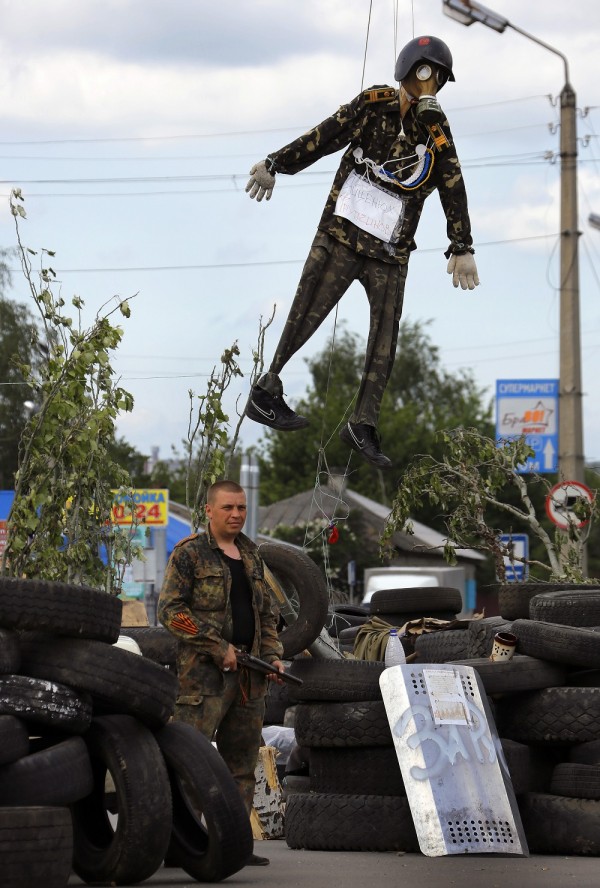Academics Debate About Black Effigies Found On Berkeley Campus
| Vittorio Hernandez | | Dec 15, 2014 05:44 AM EST |
(Photo : Reuters) An effigy of an Ukrainian soldier hangs above an armed pro-Russian rebel maning a check-point at the entrance of the eastern Ukrainian town of Slaviansk May 13, 2014. Russia said on Tuesday new European Union sanctions will hinder efforts to defuse the crisis in Ukraine and urged the West to persuade Kiev to hold discussions on the country's future structure before a May 25 presidential election. REUTERS/Yannis Behrakis (UKRAINE - Tags: POLITICS CIVIL UNREST CONFLICT)
With the spate of anti-police sentiment ongoing across several U.S. cities, it would be easy to link the discovery of three photographic images of black effigies with nooses on their necks that were hanging at the University of California, Berkeley campus to the deaths of black men in the hands of white police officers.
Like Us on Facebook
After all, two of the effigies had the famous last word of chokehold victim Eric Garner written on it -
"I can't breathe."
But even campus officials such as Chancellor Nicholas B. Dirks and Provost Claude Steel told ABC they are unsure what the intention was of the people who hanged the photographic images in prominent places of the campus.
A social psychology professor in the university, Rodolfo Mendoza-Denton, found the display of the effigies inflammatory as well as "triggering upset and anger. He added that since the protest marches already create an atmosphere of volatility, placing the effigies in prominent landmarks are misguided efforts.
Berkeley had a peaceful protest March on Saturday afternoon with about 300 participants, some of whom joined a bigger march in Oakland.
But for African American studies associate professor Leigh Raiford, it could be considered guerilla art since the images were of actual lynching victims. These images were used in the past by artists, such as Public Enemy, a rap group, for the cover of their single "Hazy Shade of Criminal" that they released in 1992.
The first image was that of black woman Laura Nelson, who was jailed in 1911 in Oklahoma because she allegedly shot to death a sheriff at her house. The body of Nelson and her 18-year-old son Lawrence, were hanged from a bridge by the lynch mob that abducted the two from their jail.
The second image tied to the campus's Sather Gate was that of 22-year-old George Meadows who was charged with rape and murder in Alabama. He was lynched by a mob of 500 men who took him from his jail and suspended him from a tree while his body was found riddled with bullets, reports the New York Daily News.
A university official said the police was investigating the incident as a hate crime.
Tagseffigy, anti-police rally, University of California Berkeley
©2015 Chinatopix All rights reserved. Do not reproduce without permission
EDITOR'S PICKS
-

Did the Trump administration just announce plans for a trade war with ‘hostile’ China and Russia?
-

US Senate passes Taiwan travel bill slammed by China
-

As Yan Sihong’s family grieves, here are other Chinese students who went missing abroad. Some have never been found
-

Beijing blasts Western critics who ‘smear China’ with the term sharp power
-

China Envoy Seeks to Defuse Tensions With U.S. as a Trade War Brews
-

Singapore's Deputy PM Provides Bitcoin Vote of Confidence Amid China's Blanket Bans
-

China warns investors over risks in overseas virtual currency trading
-

Chinese government most trustworthy: survey
-

Kashima Antlers On Course For Back-To-Back Titles
MOST POPULAR
LATEST NEWS
Zhou Yongkang: China's Former Security Chief Sentenced to Life in Prison

China's former Chief of the Ministry of Public Security, Zhou Yongkang, has been given a life sentence after he was found guilty of abusing his office, bribery and deliberately ... Full Article
TRENDING STORY

China Pork Prices Expected to Stabilize As The Supplies Recover

Elephone P9000 Smartphone is now on Sale on Amazon India

There's a Big Chance Cliffhangers Won't Still Be Resolved When Grey's Anatomy Season 13 Returns

Supreme Court Ruled on Samsung vs Apple Dispute for Patent Infringement

Microsoft Surface Pro 5 Rumors and Release Date: What is the Latest?











